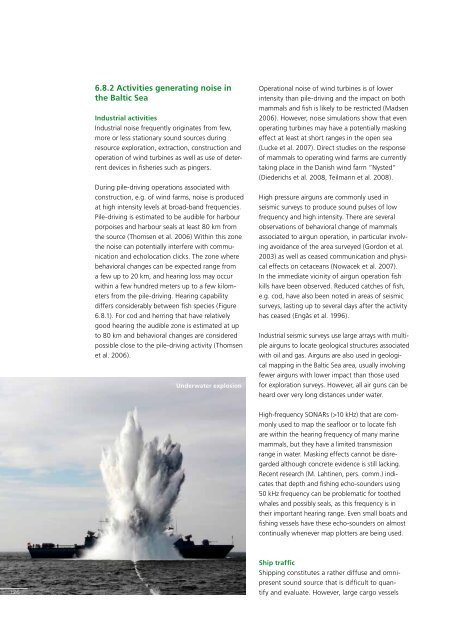BSEP116B Biodiversity in the Baltic Sea - Helcom
BSEP116B Biodiversity in the Baltic Sea - Helcom
BSEP116B Biodiversity in the Baltic Sea - Helcom
You also want an ePaper? Increase the reach of your titles
YUMPU automatically turns print PDFs into web optimized ePapers that Google loves.
6.8.2 Activities generat<strong>in</strong>g noise <strong>in</strong><br />
<strong>the</strong> <strong>Baltic</strong> <strong>Sea</strong><br />
Industrial activities<br />
Industrial noise frequently orig<strong>in</strong>ates from few,<br />
more or less stationary sound sources dur<strong>in</strong>g<br />
resource exploration, extraction, construction and<br />
operation of w<strong>in</strong>d turb<strong>in</strong>es as well as use of deterrent<br />
devices <strong>in</strong> fisheries such as p<strong>in</strong>gers.<br />
Dur<strong>in</strong>g pile-driv<strong>in</strong>g operations associated with<br />
construction, e.g. of w<strong>in</strong>d farms, noise is produced<br />
at high <strong>in</strong>tensity levels at broad-band frequencies.<br />
Pile-driv<strong>in</strong>g is estimated to be audible for harbour<br />
porpoises and harbour seals at least 80 km from<br />
<strong>the</strong> source (Thomsen et al. 2006) With<strong>in</strong> this zone<br />
<strong>the</strong> noise can potentially <strong>in</strong>terfere with communication<br />
and echolocation clicks. The zone where<br />
behavioral changes can be expected range from<br />
a few up to 20 km, and hear<strong>in</strong>g loss may occur<br />
with<strong>in</strong> a few hundred meters up to a few kilometers<br />
from <strong>the</strong> pile-driv<strong>in</strong>g. Hear<strong>in</strong>g capability<br />
differs considerably between fish species (Figure<br />
6.8.1). For cod and herr<strong>in</strong>g that have relatively<br />
good hear<strong>in</strong>g <strong>the</strong> audible zone is estimated at up<br />
to 80 km and behavioral changes are considered<br />
possible close to <strong>the</strong> pile-driv<strong>in</strong>g activity (Thomsen<br />
et al. 2006).<br />
Underwater explosion<br />
Operational noise of w<strong>in</strong>d turb<strong>in</strong>es is of lower<br />
<strong>in</strong>tensity than pile-driv<strong>in</strong>g and <strong>the</strong> impact on both<br />
mammals and fish is likely to be restricted (Madsen<br />
2006). However, noise simulations show that even<br />
operat<strong>in</strong>g turb<strong>in</strong>es may have a potentially mask<strong>in</strong>g<br />
effect at least at short ranges <strong>in</strong> <strong>the</strong> open sea<br />
(Lucke et al. 2007). Direct studies on <strong>the</strong> response<br />
of mammals to operat<strong>in</strong>g w<strong>in</strong>d farms are currently<br />
tak<strong>in</strong>g place <strong>in</strong> <strong>the</strong> Danish w<strong>in</strong>d farm “Nysted”<br />
(Diederichs et al. 2008, Teilmann et al. 2008).<br />
High pressure airguns are commonly used <strong>in</strong><br />
seismic surveys to produce sound pulses of low<br />
frequency and high <strong>in</strong>tensity. There are several<br />
observations of behavioral change of mammals<br />
associated to airgun operation, <strong>in</strong> particular <strong>in</strong>volv<strong>in</strong>g<br />
avoidance of <strong>the</strong> area surveyed (Gordon et al.<br />
2003) as well as ceased communication and physical<br />
effects on cetaceans (Nowacek et al. 2007).<br />
In <strong>the</strong> immediate vic<strong>in</strong>ity of airgun operation fish<br />
kills have been observed. Reduced catches of fish,<br />
e.g. cod, have also been noted <strong>in</strong> areas of seismic<br />
surveys, last<strong>in</strong>g up to several days after <strong>the</strong> activity<br />
has ceased (Engås et al. 1996).<br />
Industrial seismic surveys use large arrays with multiple<br />
airguns to locate geological structures associated<br />
with oil and gas. Airguns are also used <strong>in</strong> geological<br />
mapp<strong>in</strong>g <strong>in</strong> <strong>the</strong> <strong>Baltic</strong> <strong>Sea</strong> area, usually <strong>in</strong>volv<strong>in</strong>g<br />
fewer airguns with lower impact than those used<br />
for exploration surveys. However, all air guns can be<br />
heard over very long distances under water.<br />
High-frequency SONARs (>10 kHz) that are commonly<br />
used to map <strong>the</strong> seafloor or to locate fish<br />
are with<strong>in</strong> <strong>the</strong> hear<strong>in</strong>g frequency of many mar<strong>in</strong>e<br />
mammals, but <strong>the</strong>y have a limited transmission<br />
range <strong>in</strong> water. Mask<strong>in</strong>g effects cannot be disregarded<br />
although concrete evidence is still lack<strong>in</strong>g.<br />
Recent research (M. Laht<strong>in</strong>en, pers. comm.) <strong>in</strong>dicates<br />
that depth and fish<strong>in</strong>g echo-sounders us<strong>in</strong>g<br />
50 kHz frequency can be problematic for too<strong>the</strong>d<br />
whales and possibly seals, as this frequency is <strong>in</strong><br />
<strong>the</strong>ir important hear<strong>in</strong>g range. Even small boats and<br />
fish<strong>in</strong>g vessels have <strong>the</strong>se echo-sounders on almost<br />
cont<strong>in</strong>ually whenever map plotters are be<strong>in</strong>g used.<br />
126<br />
Ship traffic<br />
Shipp<strong>in</strong>g constitutes a ra<strong>the</strong>r diffuse and omnipresent<br />
sound source that is difficult to quantify<br />
and evaluate. However, large cargo vessels

















